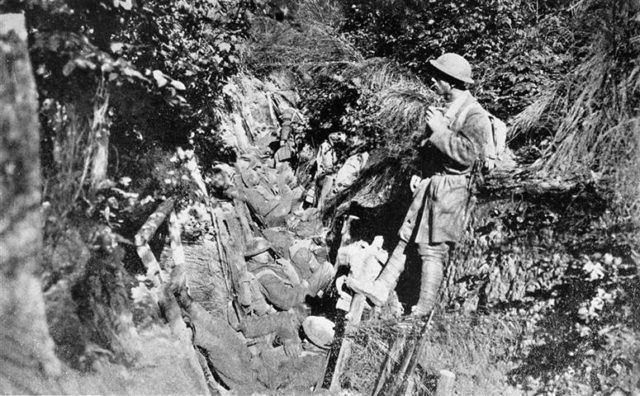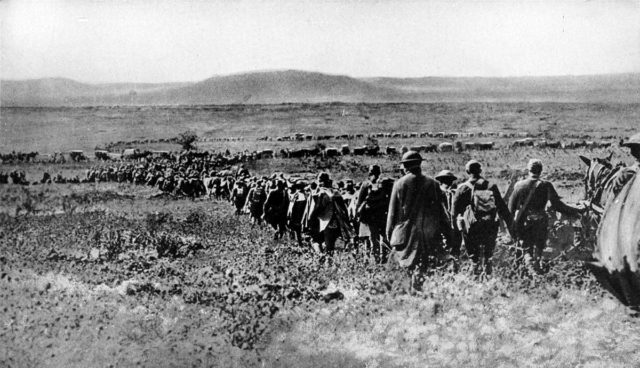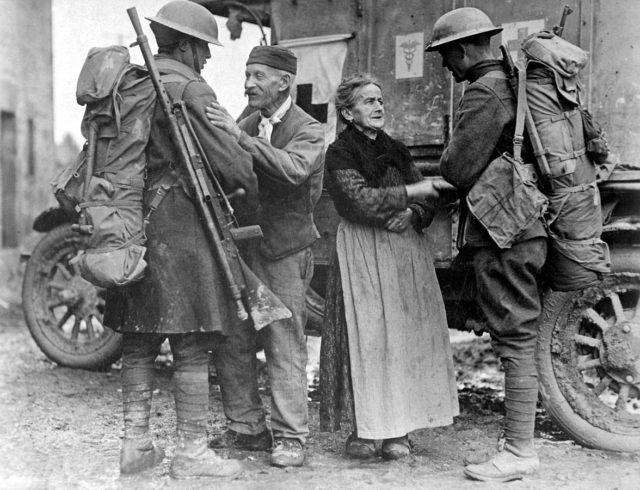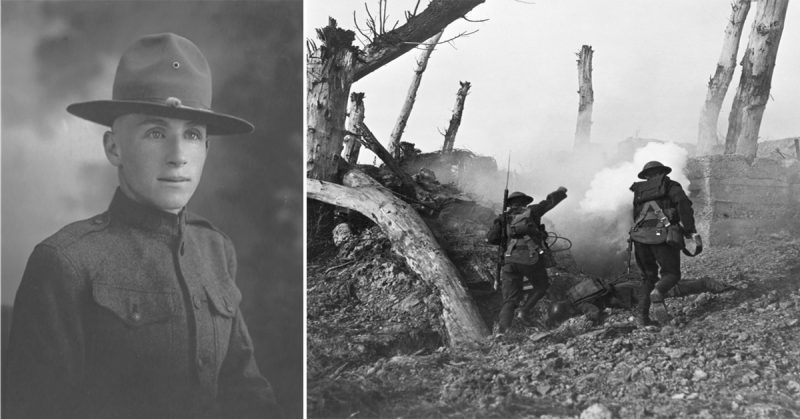War History Online presents this guest article by Dr. Paul Dean
World War I is a forgotten war for most Americans.
Few in America can name a battle or a general in a conflict even though over 100,000 Americans were dead in the war. Fewer still know what it was like for a teenage soldier to fight in trenches, go “over the top,” into machine gun fire, or endure shelling that went on for hours.
The war began in 1914 following the assassination of the heir to the Austrian-Hungarian throne by a Serbian nationalist. A web of alliances soon brought most of Europe into a brutal conflict that killed millions of soldiers and civilians. The United States (US) was able to stay out of the war until 1917. Germany’s sinking of US vessels and attempt to forge a military alliance with Mexico forced the US to enter the war and stop the madness of the world war.
The soldiers in the American Expeditionary Force (AEF) were young, inexperienced, and from various backgrounds. The average soldier was 5’7 ½” tall and 141 ½ pounds. Most volunteers did not have any prior military service. Thirty-one percent were illiterate and eighteen percent were foreign born. After declaring War on the German empire in April of 1917 the United States quickly assembled a force from existing soldiers, volunteers, and draftees. Before the war, the United States had less than 150,000 in their armed forces. By the end of World War I, they had a combat-ready force of over 2 million. The US soldiers, nicknamed “Yanks” or “Doughboys,” fought courageously in the trenches of the Western Front. Their skill and bravery strengthened their French and British Allies in the spring of 1918. Their aggressive drive in autumn of 1918 forced the Germans back to their borders and ended the war in November.
One of the unsung soldiers of World War I, was Roy Blanchard, a National Guard volunteer from Grand Rapids Michigan. He fought as part of the 32nd Division, nicknamed, “Les Terribles,” by the French. His experience gives us a window into the conflict and an idea of the courage it took to do your duty.

August 1918, outside of Juvigny, France.
It was 3:00 a.m., Roy was in his position. He knew little—about as much as the rest of the regiment. What they did know was that they were on the Juvigny plateau, a high, open ground cut up by ravines. To the extreme right was a hill that was the highest spot on this section of the front with a slope going down gently to the front. Beyond the front was the solidly-built village of Juvigny nestled in the bottom of a ravine. The Germans clung to the hill, the railroad, and the village. That stronghold was holding up the Allied advance all along the front. General John J. Pershing had sent the 32nd division, as shock troops to smash through those defenses so that the Americans could continue to drive the Germans out of France.
German artillery began at 5:00 a.m. and lasted a half hour. Thunderous krumps in the distance followed by screaming shells, red balls of fire, and showers of steel and pulverized mud. Men got small under their steel helmets and pressed close to the trench walls. When the barrage lifted, Roy and Company K stepped up to the fire-step and waited. They were told that the French artillery would give them a fifteen-minute barrage before they were to go over the top. The barrage didn’t come. Either the French hadn’t received the message, or their orders had been changed—impossible to tell at this hour. What was certain was that the German gunners would be at their positions, unmolested, and with a clear line of sight at the assault. Roy’s commanding officer weighed the matter for fifteen minutes and then decided that they would have to do without the barrage. He blew his whistle, and Roy and Company K kicked a toehold in the loose earth, grabbed hold of the top of the temporary trench, and scrambled over the top. Light was showing on the horizon, and the Americans were in the open, some of the teenage soldiers living the last few minutes of their lives.

Perhaps the Germans were waiting for the customary introductory barrage as well. Roy and the Americans trotted the 150 yards between the lines before the Germans realized that an attack was on. The Americans quickly killed dozens, hoping to survive other Germans threw up their hands and yelled, “Kamerad!” Roy found that the trenches directly in front of him were completely abandoned. Cautiously entering the trenches he looked to his right to the hillside stronghold. With sudden, awful realization, he saw the hillside bristling with machine guns pointed directly down at the length of the trench. He heard the Germans open up gun after gun, the harsh rat-a-tat-tat of the Maxim guns, bullets zipping by and thudding into the dirt as the gunner swept the trench from side to side. Vandyke fell on his right. Edwards fell on his left. Hoover fell. Out of his peripheral vision, Roy saw a support trench line running left, he pivoted to take to that ditch, desperate for cover. It was a flank attack! German troops in a long line were running toward them. Roy stopped in his tracks. Men following him from Company K slammed into each other, yelling at each other to, “back up!.” Roy froze, there was nowhere else to go. The machine-gun bullets were zipping overhead, putting holes in the trench wall and thudding into the bodies around him. He had to move. Roy scrambled from side to side, taking any cover he could find. Bullets again hit the fallen men in front of him. The next series of bullets knocked him off his feet. Pain burned in his shoulder. He looked down to see blood seeping through the hole in his drab olive jacket. Groaning, he now crawled, but it was too late—the Germans had them in their sights, and three men in front of him got hit. The man behind him fell. Two bullets hit his pack.
The German gunners switched their attention to another target, and Roy lay still for a moment, wiggled out of his pack, and carefully climbed out of the trench. Shooting at the machine guns would only draw fire at his wounded friends, and he doubted his aim at the moment anyway, with his left arm all but useless. He decided the best option was to crawl to the American lines 150 yards away. There, he could send help for his wounded friends. He couldn’t crawl and hold his rifle, so he reluctantly left that behind too. Yard by yard, he crawled: stopping from time to time to rest and breathe. His shoulder stung, and he was losing blood. Men from the second wave came up out of the original American positions to help, and finally Roy made it back to the American trenches. Pointing toward the German lines, he told them that dozens of Company K were dead or dying in the trenches. In fact, two-thirds of Roy’s friends in Company K had been killed or wounded in the deadly German counter-attack.
Roy survived his wound that day, and he and his comrades fought on. Their French allies, so impressed with their ability to dislodge German soldiers out of fixed positions nicknamed them, “Les Terribles,” and awarded them the Croix de Guerre.
Despite fierce German resistance the AEF and its allies continued to assault German positions until the Germans surrendered in November of 1918.

The peace negotiations in 1919 proved much less successful than the aggressive AEF. The resulting Treaty of Versailles blamed the Germans for the conflict. In the decades that followed the French, British, and Americans lacked the will to enforce the peace.
The job of finishing the conflict begun in 1914 fell to the next generation. Angry Germans rose up looking for scapegoats for their ruined country. The discontents looked to a bitter World War I veteran, Corporal Adolf Hitler, for leadership. Hitler successfully blamed German troubles on the unjust ending of World War I and launched a brutal war of aggression that quickly overwhelmed France and nearly brought Russia and England to their knees.
As in 1918, American soldiers came to the rescue and bravely marched across the continent of Europe. The wisecracking G.I.s in 1944–1945 often fought over the same land where Roy Blanchard and the Yanks fought in 1918.

The worldwide conflict of World War II was so compelling and the G.I.’s efforts were so consequential that they almost completely overshadowed the courage and sacrifice of the soldiers of World War I. Now, when Americans think of World War, they think of Pearl Harbor, D-Day, the Battle of the Bulge, and the dawn of the nuclear age over Hiroshima. Forgotten are the Yanks, teenage soldiers like Roy Blanchard, who sang while they marched, endured horrific shelling, and went over the top into the teeth of machine gun nests on the Western Front in 1918.
Their story of courage deserves to be told.
Dr. Paul Dean, is the author of “Courage: Roy Blanchard’s Journey in America’s Forgotten War.” Courage has been an Amazon “Hot New Release” and ranked #2 on Amazon’s ratings for World War 1 Biographies. Paul writes and speaks about a variety of historical eras connecting those to the challenges that face Americans today. Paul’s writing has been published in a variety of print and online sources. He also frequently speaks at community events including Veterans Day observances and Non-Profit fundraisers. He is married and has 4 children, including one Marine.
Dr. Paul Dean Website
